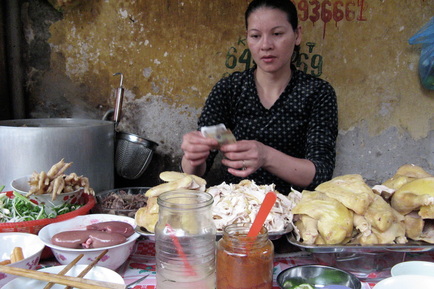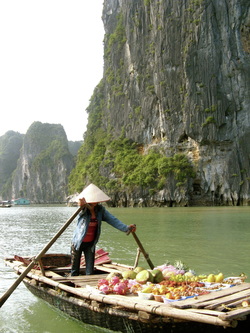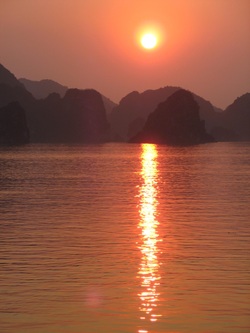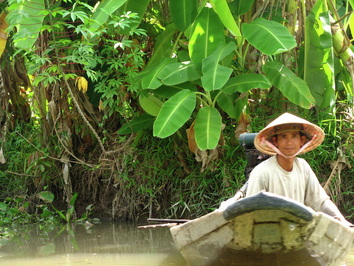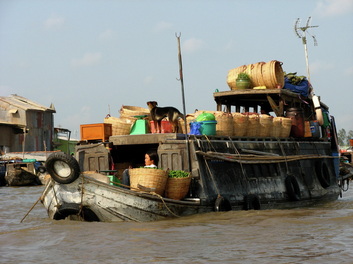War No More
To many, it is difficult to see Vietnam in a light other then war. White sand beaches, Asian culinary delights and a rich cultural heritage are not associations many foreigners readily make. However, this was the side I experienced, the side of modern day Vietnam. Where ancient eastern traditions and lifestyles mix with more recent reminders of war and colonization.
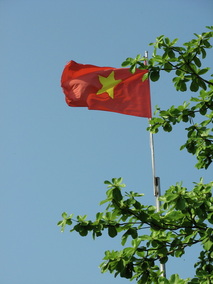
After three days of overland travel from the Tibetan border of China, I arrived in Vietnam with one thing on my mind - sleep. However, my fatigue faded just two steps across the border as I was swept away in the rhythmic lunacy of daily life. People scurrying to and fro, women executing perfect balancing acts with wicker baskets suspended precariously on bamboo sticks, rays of sun reflecting violently off the pulsating sea of rice patty hats and striking French colonial architecture rising on all sides. After three days of overland travel from the Tibetan border of China, I arrived in Vietnam with one thing on my mind - sleep. However, my fatigue faded just two steps across the border as I was swept away in the rhythmic lunacy of daily life.
People scurrying to and fro, women executing perfect balancing acts with wicker baskets suspended precariously on bamboo sticks, rays of sun reflecting violently off the pulsating sea of rice patty hats and striking French colonial architecture rising on all sides.
.
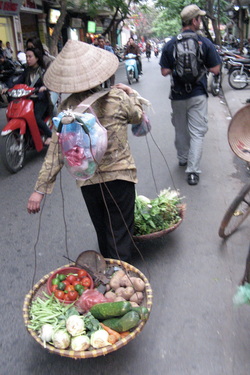
One of the first things you learn in Vietnam is that traveling from city to city can often be an adventure in itself. Flights are always an option, but with more time on my side than money, overland travel was the way to go. Train travel is also a possibility - that is if you enjoy pushing and prying your way to the front of the ticket counter. Lines do not exist here and anything goes. The best travel option, in my opinion, is by bus. Especially for those of you on a budget, the “open bus ticket” is extremely economical, costing around $20 dollars, and enabling travel to any number of pre-specified destinations between Hanoi and Saigon. If you can handle cramped bus seating for 10 hours, enjoy seemingly random overnight bus stops and roller coaster rides through the countryside, then the open bus ticket is for you.
My journey began in the picturesque Tonkinese Mountains, just across the Chinese border. Originally built by the French as a hill station retreat in 1922, the town of Sapa boasts one of the most spectacular views in all Vietnam. Unfortunately, though, Sapa sits at one of the highest elevations in Vietnam. I arrived, literally, in the middle of a cloud. When the clouds break though, and the mist rises, the dazzling emerald valleys and fertile paddies below provide a breathtaking vista. From their village homes, hill tribe women and children make the daily trek up the mountain to sell their handicrafts, fabrics, and produce in the town market. Adorned in colorful tribal attire with nothing more then crude wooden sandals on their feet, they trudge up the mountainside hauling their arduous loads. The children particularly enjoy the market as an opportunity to practice their English with foreigners. Once the children know your name and nationality they will happily show you around Sapa and encourage a visit to their hill tribe villages. Talk about a friend for life. Trekking to these neighboring villages provides a rare glimpse into traditional ethnic lifestyles rarely found in other parts of Vietnam.
.
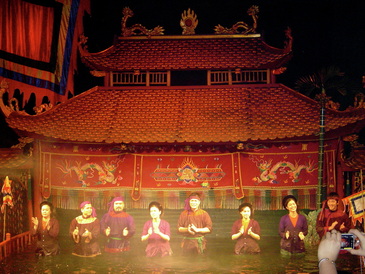
The next stop was Hanoi and “The Old Quarter”. This area is the heart and soul of not only Hanoi, but Vietnam as a whole. Days start early, with markets opening and motorbikes zooming to life well before sunrise. Hanoi is particularly famous for its Water Puppet Theatre. Using bamboo rods and complicated string synchronization techniques, puppeteers bring these wooden puppets to life. Characters emerge from underwater scene changes using the surface of the water as their stage. Shows are deeply rooted in Vietnamese folklore and symbolize stories of harvest, festivals and fishing. An absolute must-see. Hanoi is also a food lover’s dream. For me, personally, street food is the only way to go. Pho noodles are one of the most common dishes and can be found on practically every street corner. Similar to chicken noodle soup, with the addition of spicy chilies, crunchy croutons and the occasional chicken foot, it takes on a taste all its own. Baguette and pastry shops also line the streets, an edible legacy inherited from the French. Another, more internationally known specialty, is the famed spring roll. At an average price of 3,000 Dong per roll (.15 cents), it’s no wonder I was able to travel for over a month on a $500 USD budget (including food, accommodation, transport, and entertainment). Once your appetite has been sufficiently satiated, what better then something cold and refreshing to wash it all down? The Old Quarter’s “Bai Hoi” corner is quickly becoming world famous. Where else in the world can you sit on the street corner and drink 13-cent beers? Careful, $1 can take you a long way and bathroom breaks often cost more then a beer.
To the east of Hanoi is Halong Bay, a UNESCO World Heritage Sight. Massive limestone structures jut sky high from the ocean below, creating stunning coves and housing much of Vietnam’s abundant marine life. The best way to see all her splendor is via a two- to three-day boat tour. Passengers eat, sleep, and relax on the boat, while taking in all of nature’s glory. The tours visit traditional floating villages where inhabitants live entirely on the water. Holes in the house floor allow for comfortable fishing and nets cast out the windows catch unsuspecting crayfish. Like well-oiled machines, mainland locals row their boats to the floating villages to get their daily ration of fish. In return, they supply the floating villages with a veritable cornucopia of delectable fruits and vegetables.
Continuing south of Hanoi is the old port town of Hoi-An, rightly dubbed, “The Tailor Town”. To many shoppers this would be Mecca. Street after street, shop after shop of custom made suits, skirts and dresses. Want more? How about hand made shoes, purses, and jewelry? And all at a price far below any sale price here in America. If only I had a higher baggage allowance.After Hoi-An, my wallet and I needed a break. Where better to relax then in the beach capital of Vietnam, Nha Trang, where miles of luminous white sand stretch as far as the eye can see. Nha Trang also happens to be Vietnam’s premiere dive site. For me, there would never be a better time or place to get certified, not to mention a better price. Over a three-day course, consisting of pool work, classroom and four incredible ocean dives, I received my PADI Open Water Certification. With 10-meter visibility and over 350 species of marine life, I got up close and personal with moray eels, sting rays and the ever elusive, “nemo” fish. Carrying on south, I finally reached Ho Chi Min City (HCMC), also known as Saigon. With over 4.5 million motorbikes in a city of 8 million people, Saigon can easily be deemed the motorbike capital of the world. No lanes, no blinkers, no rules. Looking both ways does not cut it here. When crossing the street my advice is to commit, and once committed, don’t stop. Or, like the famous phrase, “When in Vietnam, do as the Vietnamese”, and that means mounting one of these “hogs” yourself. Renting a bike could not be easier and costs around $5 dollars per day. Surprisingly, the scariest part is not the driving, it's the dismount. Always dismount on the left, away from the muffler, as I so painfully learned. A lesson forever burned in my mind and leg for that matter. Ouch! As the largest city in Vietnam, Saigon hosts much of the nation’s industrial and commercial activity. Around since the early days of French colonization, The Ben Thanh Market still draws thousands of shoppers and vendors everyday to join in the chaotic routine.Saigon is also known for its strategic importance during the war. The War Remnants Museum stands as a perpetual memorial for all those who perished in the war, no matter their nationality. It houses stories and accounts of a side of the war not too often heard in the United States.
.
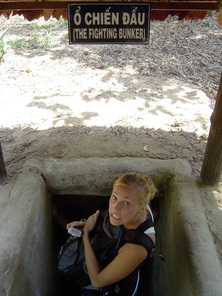
For those interested in a more tangible remembrance of war history, Southeast of Saigon are the Cu Chi Tunnels. This intricate system of underground tunnels, no more than three feet in diameter, spans a distance of over 75 miles. The three-level network of tunnels not only provided protection for villagers caught in the cross fire, but a means for Vietnamese soldiers to strategize and move about undetected.Continuing south from HCMC is the Mekong River Delta, a testament to the booming rice production industry. Terraced rice paddies cascade over the countryside, dotted by the discernable triangular straw hats of farmers hard at work. Floating down the river is like taking a step back to a time when people lived on necessities alone, with no need for modern day luxuries. Their one necessity being the Mekong River, literally translated to mean, “Mother River”.
Old, dilapidated planks held together by bamboo and twine, moor along side one another, creating a floating market spectacle. Pineapples, banana’s, cabbage, rice, even fish, take flight as they are launched overhead from boat to boat. Money is rarely exchanged here, food is the only form of currency - unless you are a tourist, that is. Then floating mini-bars will happily accept cash, maybe even VISA.After escaping the main river congestion, hundreds of smaller canals beckon for exploration. The lush surrounds and intoxicating greenery send you to a place far beyond the reaches of modern civilization. Concealing exotic fruit orchards, the melodious songs of native birds, pristine junglescapes, and a sense of unmatched serenity. One’s very own, secret garden.
After escaping the main river congestion, hundreds of smaller canals beckon for exploration. The lush surrounds and intoxicating greenery send you to a place far beyond the reaches of modern civilization. Concealing exotic fruit orchards, the melodious songs of native birds, pristine junglescapes, and a sense of unmatched serenity. One’s very own, secret garden. Having traveled closely among Vietnam’s vibrant and energetic people, I realized that feelings of bitterness and misery engendered by the turmoil of war have dissipated. Instead, feelings of hospitality, friendship and rebirth now flow freely through Vietnam, flowing like Mother River herself.
* Published April, 2006 ©
